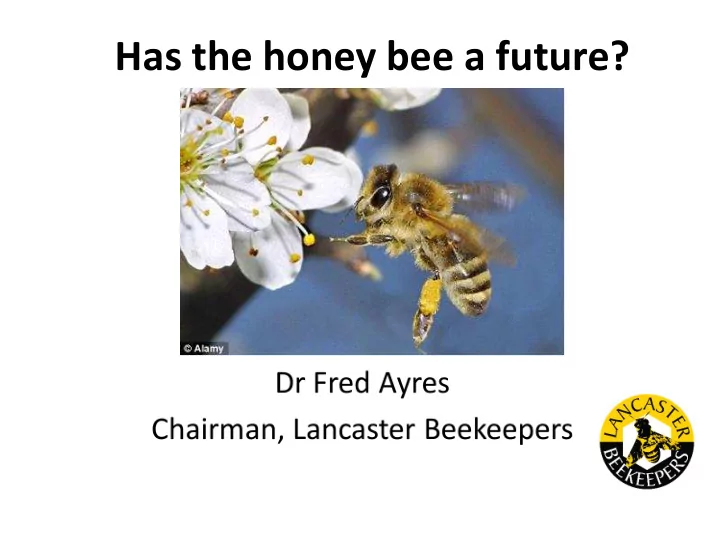

Has the honey bee a future?
Some facts about honey bees • Pollinate 60% of all commercial crops • Contribute £400m annually to the economy • Pollinate 70% of winter forage for birds and small wild animals
More facts about honey bees • Around 6 billion honey bees in UK • 95% maintained by hobbyists • Population declining by around 25% year on year
Reasons for decline • Reduction in forage due to farming practices • UK obsession with closely mown grass • Extensive use of pesticides • Foreign importations • Weather
Changing farming practices • Enriching soil • Reduction of hedges • Monoculture Possible solution – wildlife corridors
Changing farming practices
Obsession with mown grass • Verges • Publicly owned amenity land • Industrial estates Possible solution – converting unused mown grass into maintained wild flower meadows
Extensive use of pesticides Neonicotinoids are highly effective,systemic pesticides, applied to seeds that: • Kill pollinators over a period of time • Affect bees’ location senses • Are banned in most of Europe but not UK • Freely available in most Garden Suppliers
Foreign importations Italian bee A m lingustica British dark bee A m mellifera Carniolan bee A m carnica
Imported diseases American foul brood Varroa mite European Foul brood
Weather To understand how weather affects bees it is necessary to understand the bees’ life cycle
Honey bee life cycle
Honey bee life cycle Queen starts to lay eggs in mid January Around April / May bees produce queen cells Bees swarm before new queens hatch
Honey bee life cycle Newly hatched queens MUST mate successfully within 3 weeks or will never be able to lay fertile eggs Bad weather may prevent this!
Honey bee life cycle Honey bees normally live 5 to 6 weeks ► 0 - 6 days cell cleaning, general hive cleaning ► 3 - 9 days feeding the brood ► 3 - 15 days attending the queen ► 6 - 18 days honey processing ► 12 - 20 days wax production and comb building ► 20 - death hive ventilation guard duty nectar, water & propolis collection The exception is those bees hatching in October will cluster round the queen and remain largely inactive until the queen starts to lay again around January /February These bees have a maximum life span of around 26 weeks
Weather • Bad weather in Spring prevents queens from mating successfully • Long winters result in “winter” bees dying before “spring” bees hatch
We are fighting back
We are fighting back • Breeding native honey bees • Training new and developing beekeepers • Campaigning for wildlife corridors • Lobbying Council to plant wildflowers on waste land rather than cutting grass
You can help! You can help by: • Reducing use of pesticides • Planting more nectar producing plants • Reducing areas of lawns • Supporting campaigns for wildlife corridors and wildflower meadows
Recommend
More recommend